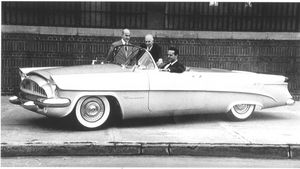.
Packard Panther

| |
| Packard Panther | |
|---|---|
| Packard | |
| Years | 1953 |
| Production | One-off concept car |
| Class | Luxury Convertible |
| Body Style | 2-Door Covertible/2-Door Hardtop |
| Length | |
| Width | |
| Height | |
| Wheelbase | |
| Weight | |
| Transmission | |
| Engine | |
| Power | |
| Similar | Packard Pan American |
| Designer | Richard Teague and Edward Macauley |
The Packard Panther was a concept car that was built by Packard in 1953. The car was originally called the Grey Wolf II, after an early Packard race car. The first Panther was taken to Daytona, Florida and set a record speed of 131.1 miles per hour, and the car was called the Panther Daytona in honor of the event.
See Wikicars' comprehensive Packard_Panther Review.
Recent Changes
Styles and Major Options
Pricing
Gas Mileage
Reliability
Safety
Photos
Colors
Main Competitors
Unique Attributes
Resale Values
Criticisms
Worldwide
Design quirks and oddities
Awards
See also
| image (between 170-190 pixels) | ||
| PACKARD | ||
|
Studebaker-Packard Corporation Clipper | Packard | Studebaker | Ultramatic Models 200 · 300 · Caribbean · Cavalier · Clipper · Clipper Constellation · Eight · Light Eight · Super Eight · Executive · Four Hundred · Hawk · One-Eighty · One-Ten · One-Twenty · Patrician · Packard Six · Twin Six/Twelve · Station Sedan · Studebaker based Packards Concept Models Balboa-X · Pan American · Panther · Predictor · Request · Special Speedster One-Off Customs Brown Bomber · El Paso · Pacifica · Parisian · Howard Darrin · James J. Nance · James Ward Packard · William Dowd Packard · George T. Christopher · Hugh Ferry · Alvan Macauley · Edward Macauley · Jesse Vincent · Richard Teague · John Reinhart | ||
| James Ward Packard and William Dowd Packard | None; Defunct | A division of the Studebaker-Packard Corporation |

